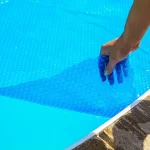
Unlike chlorine, saltwater is softer and less corrosive to pool surfaces, as well as to people. Plus, you won’t experience the chemical smells and dry skin and hair associated with other chlorine pools. Also, a salt water pool doesn’t require chlorine pucks for maintenance. And, it’s less expensive to buy and own.
But salt can still cause some problems. Although it doesn’t harm humans, it can damage the pool equipment and decks. While it can be a great cost-saving measure, it can cause damage to the pool’s water chemistry. If the pH isn’t balanced, the water chemistry can cause problems. Also, salt will cause calcium precipitant, which can leave a rough surface.
When choosing salt for a pool, make sure it contains at least ninety percent sodium chloride. This is to prevent bacteria from growing. Avoid using food-grade iodized salt. Instead, choose solar or machine-evaporated sea salt. This salt is the purest form of sodium chloride and doesn’t contain any bacteria from the sea.
A salt water pool also requires regular water testing and cleaning of the salt cell. Regular testing will ensure a healthy pool and prevent problems from occurring. The test results will indicate if there are any chemical imbalances in the water. You also need to shock the water in your pool once in a while to ensure that it is clean and healthy.
Salt water pools require the addition of a chlorine generator, whereas chlorine pools require the addition of chlorine directly to the water. However, compared to chlorine pools, salt water pools offer the same results and swimming conditions. If you’re considering adding a salt water pool, it’s best to consult a Poolwerx technician.
A salt water pool can also be heated with a conventional pool heating system. A salt water pool also requires a special pump and filter, though they’re compatible with most common pool filters. For instance, sand filters are compatible with saltwater systems, as are cartridge filters and diatomaceous earth filters. But be warned that these systems require a lot of maintenance, and it’s important to understand that they generate chlorine only when the filter is running.
One major downside of a salt water pool is the initial expense. A salt chlorine generator costs between $400 and $2,000 to buy and install. Another significant cost is the cost of replacing the salt cells, which typically last three to seven years. And you have to factor in the cost of chlorine, which can run into the hundreds of dollars a month.










